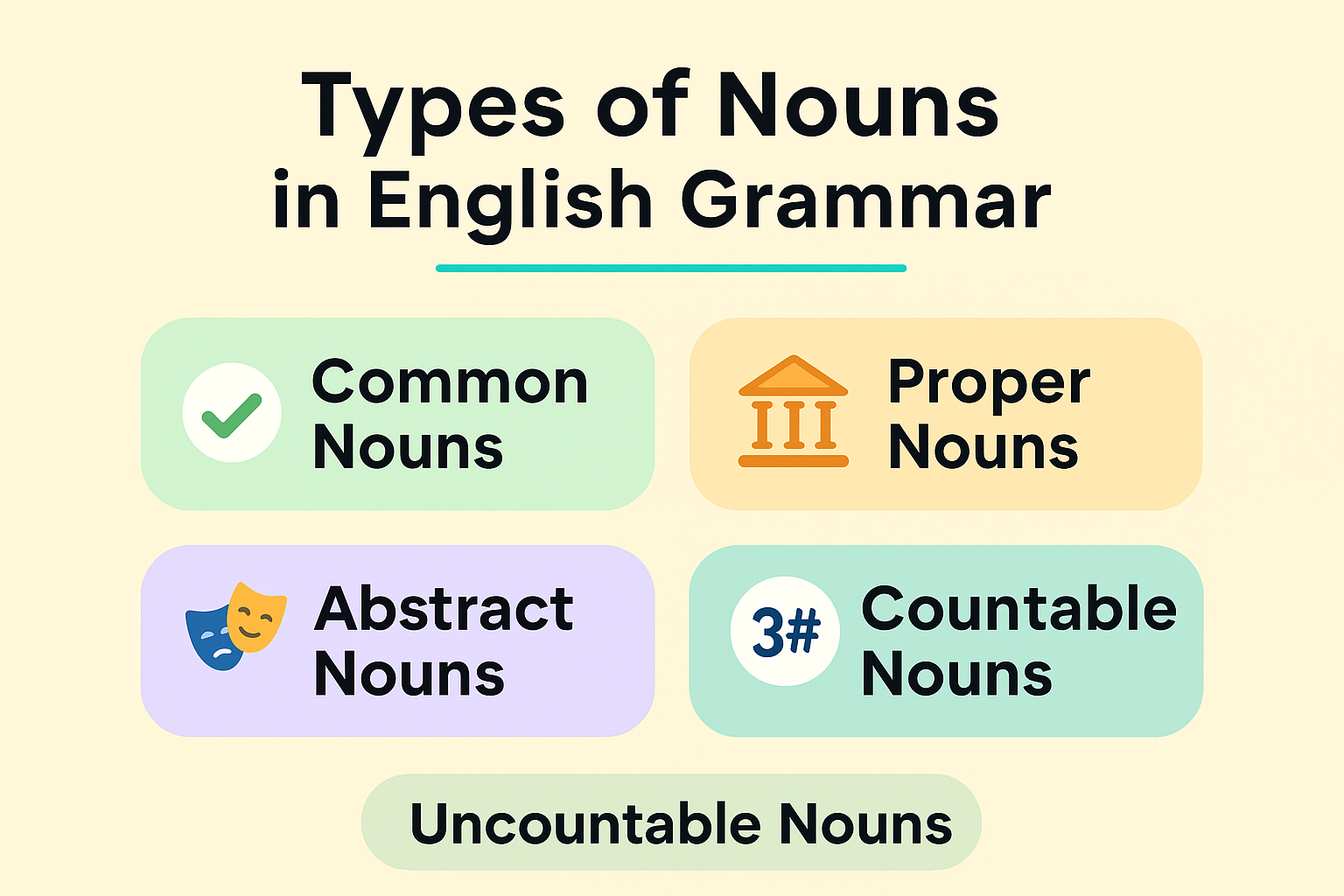Table of Contents
Types of nouns in English grammar
Learning Source: This blog is based on an English grammar lesson taught in Kannada by Yuvaraj Madha Sir. I’m sharing what I learned as a beginner to help others who want to learn English from scratch. All credits go to him—I’m just a student trying to explain in simple words.
Understanding the Basics: Parts of Speech
To write or speak good English, you must first understand what kind of words you’re using. These are known as parts of speech—the foundation of every sentence.
There are 8 parts of speech in English, but in this beginner’s guide, we will focus on 5 essential ones that we use daily:
- Noun
- Pronoun
- Adjective
- Verb
- Adverb
Let’s begin with the most important one: the noun.
What Is a Noun?
A noun is a word that names a person, place, thing, idea, or feeling.
Examples:
- Person: Ravi, Doctor, Yuvaraj
- Place: Mysore, India
- Thing: Chair, Pen
- Idea or Emotion: Love, Joy, Belief
In a sentence, nouns can function as:
- The subject (the one doing the action)
- The object (the one receiving the action)
Example Sentence:
Ravi hit Kiran on the face.
- Ravi → Subject (Noun)
- Kiran → Object (Noun)
- Face → Object of preposition (Noun)
Types of Nouns in English Grammar
Let’s explore the most common types of nouns in English grammar with simple examples.
1. Common Nouns
These are general names of people, places, or things.
Examples: teacher, country, animal, phone, city
2. Proper Nouns
These are specific names of people, places, or brands.
Always begin with a capital letter.
Examples: Bangalore, Yuvaraj, Samsung, India, Diwali
3. Abstract Nouns
These refer to feelings, emotions, or ideas that we cannot touch or see physically.
Examples: happiness, honesty, freedom, anger, success
4. Countable Nouns
These are things we can count and usually have singular and plural forms.
Examples:
- A book, two books
- An apple, many apples
- Few chairs, several friends
Used with: a, an, many, few, several, one, two
5. Uncountable Nouns
These are things we cannot count individually or separate easily.
Examples: water, rice, milk, information, furniture
Used with: much, little, some
Incorrect: a water, many information
Correct: a bottle of water, a piece of information

Countable vs. Uncountable – Quick Comparison
| Uncountable | Countable Expression |
|---|---|
| water | a glass of water |
| advice | a piece of advice |
| hair | a strand of hair |
| furniture | a piece of furniture |
| rice | a grain of rice |
| cake | a slice of cake |
Use phrases like “a piece of”, “a bottle of”, or “a grain of” to turn uncountable nouns into countable expressions.
Nouns That Can Be Both Countable and Uncountable
Some nouns change meaning depending on how they’re used.
➤ Time
- Uncountable: Take your time.
- Countable: I had a great time at the event.
➤ Experience
- Uncountable: She has work experience.
- Countable: I had two scary experiences today.
Other examples: conversation, thought, pity
Are Illnesses Countable?
Yes, in English, common illnesses are usually countable.
Examples:
- a cold
- a headache
- a stomach ache
- a toothache
- an earache
Tip: British English sometimes says “I have cold” (without “a”), but saying “a cold” is more correct and clear for learners.
Capitalization Rules for Nouns
Always use capital letters for:
- Names of people: Ram, Sanju
- Titles: Dr. Kumar, Mrs. Patil
- Days and months: Sunday, March
- Festivals and holidays: Diwali, Christmas
- Places and institutions: India, Mars, Oxford University
- Languages, nationalities, and religions: Kannada, French, Sikh
Final Thoughts
Understanding the types of nouns in English grammar is an important step in mastering sentence structure. It becomes much easier when explained in your mother tongue—thank you to Yuvaraj Madha Sir for making these concepts simple and fun through Kannada.
If you’re also starting your English journey and need easy-to-understand lessons, do explore his videos. They’re perfect for absolute beginners like me.
If you want to learn English grammar in Kannada, I highly recommend visiting Yuvaraj Madha Sir’s YouTube channel. His videos are simple, practical, and beginner-friendly.
Watch on YouTube – Yuvaraj Madha English Class
Download My Handwritten Notes
Here are my personal notes from Yuvaraj Madha Sir’s class, for easy understanding.





Pingback: Aptitude Tricks for Beginners – My Day 1 Journey with Fun Math Shortcuts - Monika's Study Space
Pingback: Java Introduction to Programming: My Exciting Day 1 Journey from Zero to Beginner - Monika's Study Space
Pingback: Data Cleaning with Titanic Dataset: Top 7 Preprocessing Tips to Master ML - Monika's Study Space
Pingback: Ultimate Java Learning Roadmap (2025) – Beginner to Advanced (Self-Study Plan) - Monika's Study Space